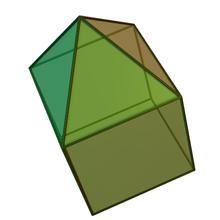Elongated square pyramid
| Elongated square pyramid | |
|---|---|
 | |
| Type | Johnson J7 - J8 - J9 |
| Faces | 4 triangles 1+4 squares |
| Edges | 16 |
| Vertices | 9 |
| Vertex configuration | 4(43) 1(34) 4(32.42) |
| Symmetry group | C4v, [4], (*44) |
| Rotation group | C4, [4]+, (44) |
| Dual polyhedron | self |
| Properties | convex |
| Net | |
 | |
In geometry, the elongated square pyramid is one of the Johnson solids (J8). As the name suggests, it can be constructed by elongating a square pyramid (J1) by attaching a cube to its square base. Like any elongated pyramid, it is topologically (but not geometrically) self-dual.
A Johnson solid is one of 92 strictly convex polyhedra that is composed of regular polygon faces but are not uniform polyhedra (that is, they are not Platonic solids, Archimedean solids, prisms, or antiprisms). They were named by Norman Johnson, who first listed these polyhedra in 1966.[1]
Dual polyhedron
The dual of the elongated square pyramid has 9 faces: 4 triangular, 1 square and 4 trapezoidal.
| Dual elongated square pyramid | Net of dual |
|---|---|

|

|
Related polyhedra and Honeycombs
Johnson solid No.8 Elongated square pyramid(Cube and Square pyramid) fill the space with Tetrahedron.[2]
See also
References
- ^ Johnson, Norman W. (1966), "Convex polyhedra with regular faces", Canadian Journal of Mathematics, 18: 169–200, doi:10.4153/cjm-1966-021-8, MR 0185507, Zbl 0132.14603.
- ^ http://woodenpolyhedra.web.fc2.com/J8.html
External links
- Weisstein, Eric W. "Elongated square pyramid". MathWorld.
- Weisstein, Eric W. "Johnson solid". MathWorld.
